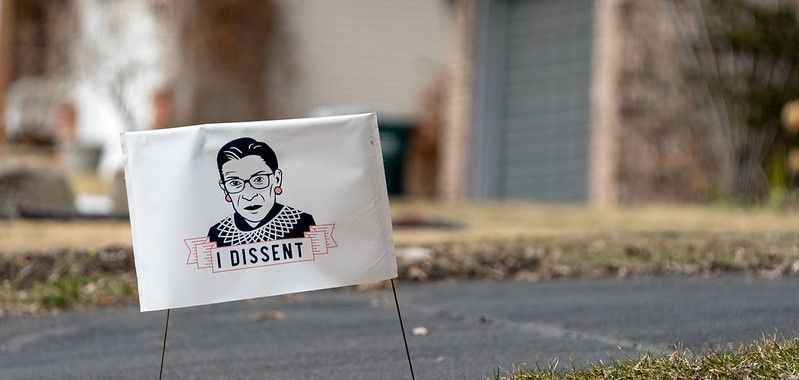When I first heard the news of Justice Ruth Bader Ginsburg’s death, I was crestfallen. Memories from law school came back to me, as I recalled reading her famous dissents in my constitutional law class. Justice Ginsburg has been an inspiration to me, not only as a representation of the heights that a female attorney can reach, but also as a champion for women’s rights. Her life’s work, including her work as an attorney before becoming a Supreme Court Justice, has helped move women closer to true equality.
Justice Ginsburg’s voice on the Supreme Court, no doubt, was shaped by her life’s experiences. As a young woman, she was one of only nine female students to attend Harvard Law School in 1956. She was a stellar student, yet was also married and caring for a 14-month-only baby. To keep her family together, she transferred to Columbia Law School and graduated in a tie for first in her class. Despite her academic and personal achievements, she was rejected from a Supreme Court clerkship by Justice Felix Frankfurter because she was female. In fact, Justice Ginsburg did not receive any job offers.
In time, she finally obtained a clerkship for the honorable Judge Edmund L. Palmieri of the U.S. District Court for the Southern District of New York, and then moved into academia. It was during this period that she learned she was being paid less than her male counterparts for the same work. Justice Ginsburg would go on to co-found The ACLU Women’s Rights Project in 1972, through which she participated in hundreds of gender discrimination cases.
Justice Ginsburg was appointed to the United States Court of Appeals for the District of Columbia in 1980, and then to the United States Supreme Court in 1993. During her tenure as a Supreme Court Justice, one particular dissent stands out in my mind, particularly as my practice is focused on employment law: the Lilly Ledbetter case.
Lilly Ledbetter was a retired employee of the Goodyear Tire and Rubber Company who discovered that she had been paid less than her male counterparts throughout her nineteen years with the company. Ms. Ledbetter sued Goodyear for gender discrimination, which led to a dispute over whether she had brought her claims within the statute of limitations.
In 2007, in a 5-4 decision, the Supreme Court dismissed Ledbetter’s claim, ruling that she raised the claim after the 180-day statute of limitations imposed by the Civil Rights Act of 1964. Ms. Ledbetter had received paychecks within the prior 180 days, the amounts of which had been impacted by a prior decision to discriminate. Yet because the original intention to discriminate lay before the 180-day period, the Court Ms. Ledbetter’s claim. What mattered to the majority was the time of discriminatory intent to pay Ms. Ledbetter less than men, not the ongoing effects of the initial decision to discriminate that showed up in each paycheck after that decision. Justice Ginsburg wrote a dissenting opinion, which she read aloud in order to bring attention to the issue of gender pay disparities.
Justice Ginsburg pointed out that Ms. Ledbetter could not have filed her lawsuit any sooner than she did because she was not aware of the years of discrimination she faced until after the fact. Ginsburg reasoned that this was how racial and gender disparities often cropped up, revealing themselves slowly. She argued that pay disparities are significantly different from other types of discrimination, such as termination or failure to promote, which are “easy to identify” and allow a worker to immediately seek redress. Pay discrimination on the other hand is often “hidden from sight,” occurs in increments, and becomes evident only over time.
Ginsburg called on Congress to correct this with legislation to overturn the Court’s decision. One of the first bills signed into law by President Barack Obama was the Lilly Ledbetter Fair Pay Act of 2009. Under this law, each paycheck that is simply impacted by a discriminatory decision resets the 180-day limit to file a claim, in order to ensure that individuals subjected to illegal pay discrimination may assert their rights.
Since then, numerous laws at the federal and state level have been passed to further prevent a gender pay divide. Just last year, Illinois amended its Equal Pay Act to make it unlawful to ask about a job applicant’s salary history. Thus, if a woman is subjected to pay discrimination with one employer, she will not have to take that “lower pay” with her to a new workplace. This is just one example of how Justice Ginsburg’s work—including her famous dissents—has had a lasting impact on our country.
Justice Ginsburg will be remembered as a judge who used the law as a tool to draw our attention to the dignity of regular people, especially those who have been treated unfairly. She had a wry way of making us see our own reality in a new light. My favorite quote of Justice Ginsburg is, “When I'm sometimes asked 'When will there be enough (women on the Supreme Court)?' and my answer is, 'When there are nine,' people are shocked. But there'd been nine men, and nobody's ever raised a question about that." R.I.P., R.B.G.

